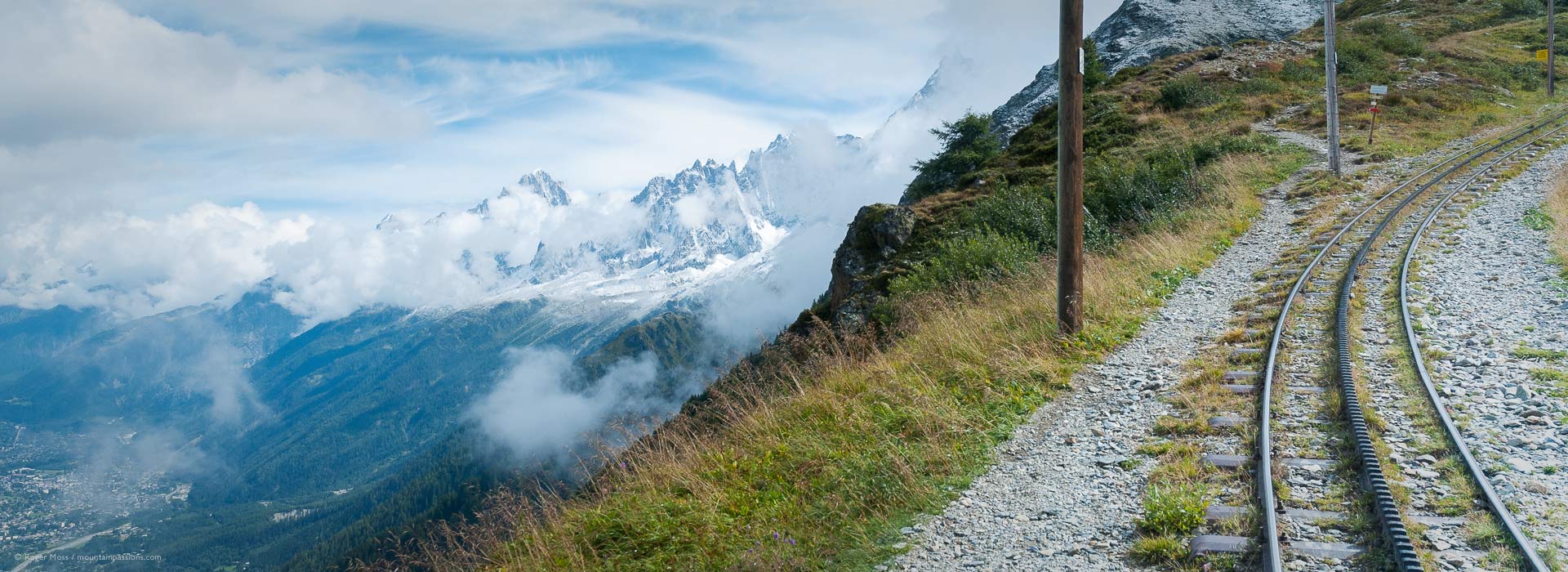
Ride the Tramway du Mont Blanc
Ride the spectacular tramway
When the very first passengers arrived at the Nid d’Aigle in 1913, few of them would previously have seen the mountain scenery from an altitude of 2373m. But what would really have taken their breath away would have been the astonishing journey they’d just accomplished. Today one of the original locomotives is proudly preserved at the gare in Le Fayet. Originally ordered purely for the initial construction phase of the line (which was intended from the outset to be electrified), financial problems saw it and its companions powering generations of passengers up and down the mountain for over 50 years. Over a century later, the Tramway du Mont-Blanc has become world-famous, and remains as sensational as ever, as we discover.
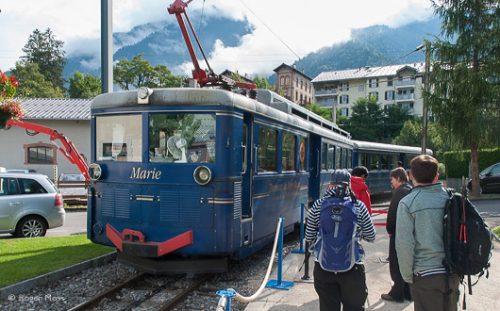
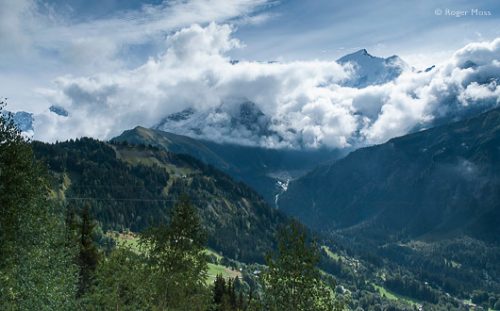
On the rack
The line begins climbing from the moment it slips from the lower terminus at Le Fayet. At first the gradient is relatively benign, but once beyond Saint Gervais things steepen dramatically, to the point where it would be impossible without the aid of a spur gear concealed beneath the driving wheels of the traction car and engaged in a toothed rack laid between the metre-guage tracks — the classic rack-railway (‘train à crémaillère’) system. When steam locomotives (Swiss-built, between 1903 and 1911) worked the line their operating speed on non-rack sections was 15km/h, falling to 7km/h once the rack was engaged. Today’s electrically-powered rolling stock, introduced in 1957, is subject to similar constraints, but the average speed for the journey is typically around 16km/h.
Col de Voza
The line soon enters forest, where progress feels sedate, but the occasional glimpse out across the valley reveals the village of Les Contamines already shrinking steadily far below. As the forest begins to thin, however, it’s the view beyond the valley which quickens the pulse, as the clouds part to reveal the unmistakable outline of Mont-Blanc. Seen from here, the plans of early entrepreneur Saturnin Fabre, who in 1896 proposed running the line all the way to the summit, seem even more audacious.
The climb eases briefly at the Col de Voza (alt.1653m) a popular drop-off point in summer for walkers (and in winter for skiers joining the downhill pistes of Les Houches). Passenger trains first reached the Col in July 1909, but the services really only became profitable during the 1920s, following the growth in popularity of winter sports, particularly in anticipation of the 1923/24 Chamonix Mont-Blanc Winter Olympics.
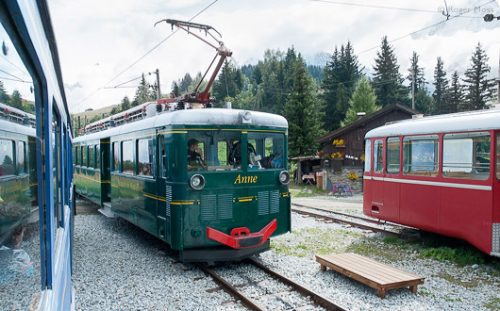
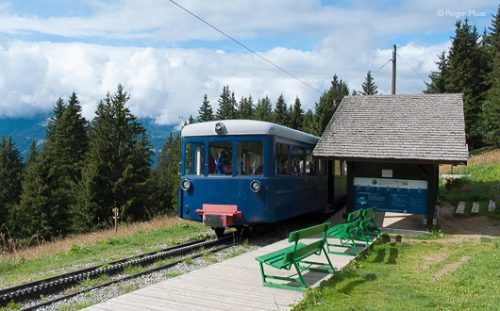
Bellevue: in winter the line stops here
The next halt, a relatively short distance beyond the col, is at the plateau de Bellevue (alt. 1794m), which in 1896 gained a substantial hotel (in recent years demolished and totally reconstructed) and which in 1936 gained a cable-car link direct from Les Houches. In winter Bellevue is also where the tramway terminates, as virtually the whole of the substantial climb which still lies beyond this point is considered to be at risk from avalanches. The trains nevertheless provide spectacular, if unlikely additions to the high-altitude snowy landscape, to the obvious delight of passing skiers.
Beyond the plateau the line suddenly launches into a tight curve and begins the steep climb to Le Mont Lachat, where a forlorn-looking building with a distinctly military appearance at the trackside was home during the 1930s to teams of researchers from the Société Nationale de Construction de Moteurs (SNCM) testing how aero engines would behave at altitude (2115m) and at temperatures low enough to provoke icing. This little piece of local history is about to disappear, however — the building is scheduled for removal, as part of a WWF-supported environmental initiative to return the site to its natural state.
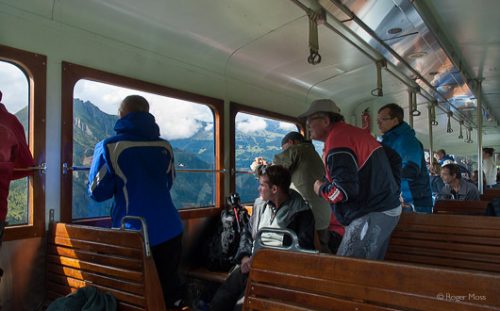
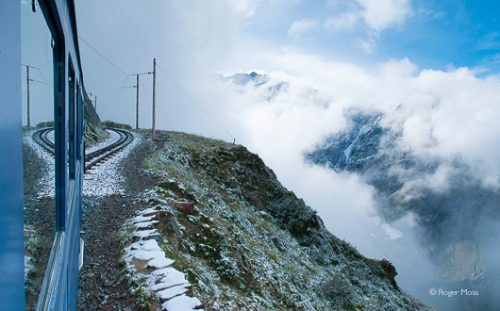
To the eagles’ nest
Once past the already remote-feeling site the line resumes its climb, this time through a dramatically-changing craggy landscape. The scenery across the broad valley below and far beyond is hypnotic, but ultimately it’s the view up ahead which focuses the attention, as the line hugs the side of the mountain on what looks like an unnervingly narrow ledge and winds its way relentlessly higher. Up here among the swirling clouds, our sunny starting point way down in Le Fayet suddenly seems like a world apart.
Eventually, after a brief interlude of passing through dense mist and cloud, things clear and ahead we see a tunnel entrance. As we enter the train slows to a walking pace, and when it emerges into daylight we can see why — we’ve quite literally reached the end of the line. We’re far from level, however, and what’s more the rear of the second carriage is still in the darkness of the tunnel.
Not that there’s a choice, for as we step out of the train (not onto a platform, but to a set of reassuringly-sturdy timber steps) we can clearly see the track simply petering-out among the rocks just a few metres ahead of the train. Long ago, as far back as 1835, in fact, the projects proposed included continuing to the summit of Mont-Blanc by means of a cutting in a glacier — something which was never going to work, since glaciers are constantly edging their way down the mountainside.
Next Stop – Mont Blanc
Sixty years later another plan suggested using tunnels to permit the line to reach 2800m, whereupon the remaining 2000m or so to the summit would be accomplished by vertical lifts. Unsurprisingly, this terrifying concept was also discounted, in favour of Saturnin Fabre’s altogether more attainable project on which the present line was founded. Up here, though, you have to say that what was achieved by the early constructors still counts as a civil engineering project on a truly heroic scale.
The track reached the Nid d’Aigle on 1st August 1913, at which time an onward route was already pegged-out towards the glaciers of Bionassay and Tête-Rousse. The prospect of costly tunnels, coupled with the collapse of passenger revenue after the general mobilisation was decreed prior to the outbreak of WWI, put an end to the plans.
As it is, Bionassay is accessible to walkers from the Nid d’Aigle via a high-mountain footpath, as are the refuges of Le Goûter and Tête-Rousse (for those planning an ascent of Mont-Blanc). Passengers just here for the ride, on the other hand, have a long enough stop to admire or photograph the scenery. Conditions are unsettled for our visit, but in fine weather you’ll be treated to views you’ll never forget.
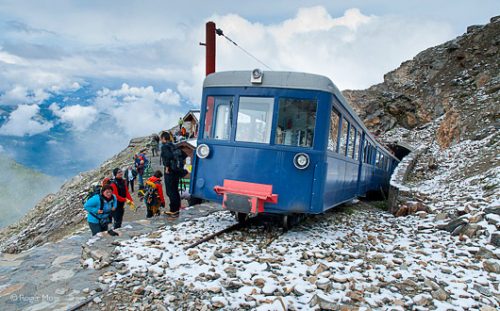
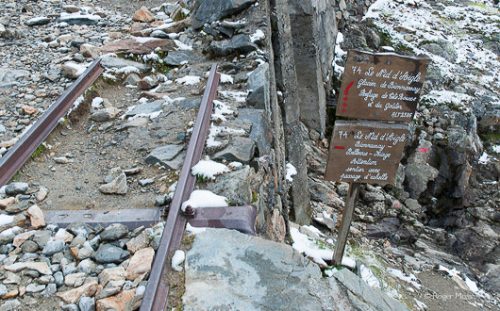
Gently down to earth
The return journey feels in every sense like coming back down to earth, as the snow-dusted, rocky landscapes gradually give way to altogether more hospitable Alpine pastures, complete with grazing cattle. We leave the train at Bellevue, to explore some of the local footpaths and other terrain which on previous visits had been hidden beneath our skis, before taking the next train from the Col de Voza back down to Le Fayet.
Riding the Tramway du Mont-Blanc is an exhilarating experience, even for visitors who have long since become blasé about modern high-speed rail travel. The long descent is accompanied by a symphony of clanking and whining, as the time-warp 1950s rolling stock feels its way back down the steep mountain gradients. What it must have felt and sounded like under steam power we’ll never know…
